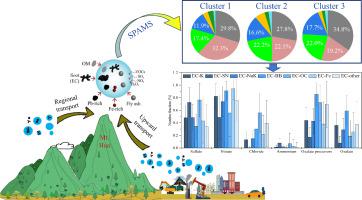当前位置:
X-MOL 学术
›
Sci. Total Environ.
›
论文详情
Our official English website, www.x-mol.net, welcomes your feedback! (Note: you will need to create a separate account there.)
Exploring secondary aerosol formation associated with elemental carbon in the lower free troposphere
Science of the Total Environment ( IF 9.8 ) Pub Date : 2024-05-07 , DOI: 10.1016/j.scitotenv.2024.172992 Li Li , Qiyuan Wang , Jie Tian , Yaqing Zhou , Nan Ma , Huikun Liu , Yang Zhang , Shuoyuan Chen , Jin Wang , Yukun Chen , Weikang Ran , Jianjun Li , Junji Cao
Science of the Total Environment ( IF 9.8 ) Pub Date : 2024-05-07 , DOI: 10.1016/j.scitotenv.2024.172992 Li Li , Qiyuan Wang , Jie Tian , Yaqing Zhou , Nan Ma , Huikun Liu , Yang Zhang , Shuoyuan Chen , Jin Wang , Yukun Chen , Weikang Ran , Jianjun Li , Junji Cao

|
The variability of element carbon (EC) mixed with secondary species significantly complicates the assessment of its environmental impact, reflecting the complexity and diversity of EC-containing particles' composition and morphology during their ascent and regional transport. While the catalytic role of EC in secondary aerosol formation is recognized, the effects of heterogeneous chemistry on secondary species formation within diverse EC particle types are not thoroughly understood, particularly in the troposphere. Alpine sites offer a prime environment to explore EC properties post-transport from the ground to the free troposphere. Consequently, we conducted a comprehensive study on the genesis of secondary aerosols in EC-containing particles at Mt. Hua (altitude: 2069 m) from 1 May to 10 July, using a single particle aerosol mass spectrometer (SPAMS). Our analysis identified six major EC particle types, with EC-K, EC-SN, and EC-NaK particles accounting for 27.6 %, 27.0 %, and 19.6 % of the EC particle population, respectively. The concentration-weighted trajectory (CWT) indicated that the lower free troposphere over Mt. Hua is significantly affected by anthropogenic emissions at ground-level, predominantly from northwestern and eastern China. Atmospheric interactions are crucial in generating high sulfate levels in EC-SN and EC-OC particles (> 70 %) and notable nitrate levels in EC-K, EC-BB, and EC-Fe particles (> 80 %). The observed high chloride content in EC-OC particles (56 ± 32 %) might enhance chlorine's reactivity with organic compounds via heterogeneous reactions within the troposphere. Distinct diurnal cycles for sulfate and nitrate are mainly driven by varying transport dynamics and formation processes, showing minimal dependency on EC particle types. Enhanced nocturnal oxalate conversion in EC-Fe particles is likely due to the aqueous oxidation of precursors, with Fe-catalyzed Fenton reactions enhancing OH radical production. This investigation provides critical insights into EC's role in secondary aerosol development during its transport in the lower free troposphere.
更新日期:2024-05-07






























 京公网安备 11010802027423号
京公网安备 11010802027423号